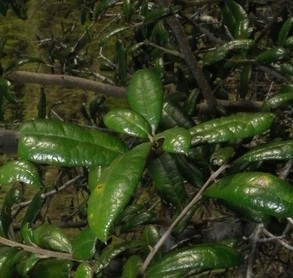Sand live oak
(Quercus langbianensis)

Description
Quercus geminata, commonly called sand live oak, is an evergreen oak tree native to the coastal regions of the subtropical southeastern United States, along the Atlantic Coast from southern Florida northward to southeastern Virginia and along the Gulf Coast westward to southern Mississippi, on seacoast dunes and on white sands in evergreen oak scrubs. A small- to medium-sized tree, the sand live oak is scrubby and forms thickets. The bark is dark, thick, furrowed, and roughly ridged. The leaves are thick, leathery, and coarsely veined, with extremely revolute margins, giving them the appearance of inverted shallow bowls; their tops dark green, their bottoms dull gray and very tightly tomentose, and their petioles densely pubescent, they are simple and typically flat with bony-opaque margins, having a length of 2–12 centimetres (3⁄4–4+3⁄4 inches) and a width of 0.5–4 cm (1⁄4–1+1⁄2 in). The male flowers are green hanging catkins. The acorns are small, 1–2.5 cm, oblong-ellipsoid or ovoid, and are commonly born in pairs on peduncles of varying lengths. In coastal Florida's evergreen oak scrub, the sand live oak is a ubiquitous and abundant species; the threatened Florida scrub-jay is found only in Florida scrub. Live oaks, having characteristics of the sand live oak and the southern live oak (Q. virginiana), grow further inland. It is believed that these specimens are hybrids of Q. geminata and Q. virginiana. While hybridization occurs between Q. geminata and Q. virginiana, the two species are genetically and morphologically distinct. The Cuban oak, Q. sagraeana, has been purported to be a hybrid between the sand live oak and Q. oleoides, but recent evidence suggests that the Cuban oak is a separate species without hybrid origin. An oak is a tree or shrub in the genus Quercus ("oak tree") of the beech family, Fagaceae. There are approximately 500 extant species of oaks. The common name "oak" also appears in the names of species in related genera, notably Lithocarpus (stone oaks), as well as in those of unrelated species such as Grevillea robusta (silky oaks) and the Casuarinaceae (she-oaks). The genus Quercus is native to the Northern Hemisphere, and includes deciduous and evergreen species extending from cool temperate to tropical latitudes in the Americas, Asia, Europe, and North Africa. North America has the largest number of oak species, with approximately 160 species in Mexico of which 109 are endemic and about 90 in the United States.
Taxonomic tree:







